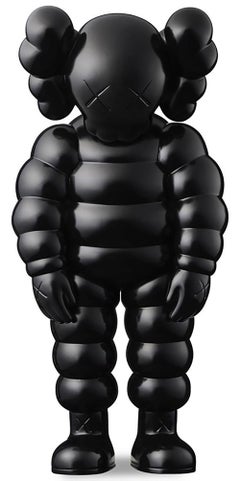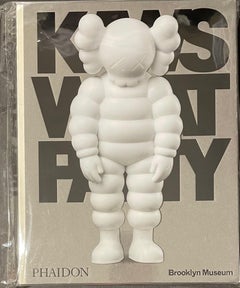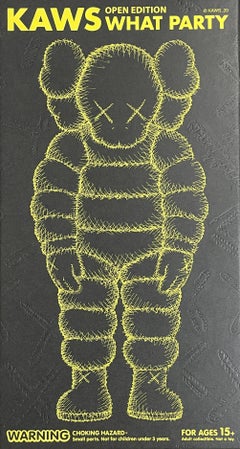Kaws What Party Black
21st Century and Contemporary Pop Art More Art
Resin, Vinyl
2010s Pop Art More Art
Black and White
2010s Street Art More Art
Vinyl
21st Century and Contemporary Pop Art Prints and Multiples
Resin, Vinyl
Recent Sales
21st Century and Contemporary Pop Art Figurative Sculptures
Resin, Vinyl
21st Century and Contemporary Pop Art Figurative Sculptures
Resin, Vinyl
21st Century and Contemporary Pop Art Prints and Multiples
Resin, Vinyl
21st Century and Contemporary Pop Art Prints and Multiples
Resin, Vinyl
21st Century and Contemporary Pop Art Figurative Sculptures
Resin, Vinyl
21st Century and Contemporary Pop Art Figurative Sculptures
Resin, Vinyl
21st Century and Contemporary Pop Art Prints and Multiples
Resin, Vinyl
21st Century and Contemporary Pop Art Figurative Sculptures
Resin, Vinyl
21st Century and Contemporary Pop Art Figurative Sculptures
Resin, Vinyl
21st Century and Contemporary Pop Art Figurative Sculptures
Resin, Vinyl
21st Century and Contemporary Pop Art Figurative Sculptures
Resin, Vinyl
21st Century and Contemporary Pop Art Figurative Sculptures
Resin, Vinyl
21st Century and Contemporary Pop Art Figurative Sculptures
Resin, Vinyl
21st Century and Contemporary Pop Art Abstract Sculptures
Resin, Vinyl
21st Century and Contemporary Pop Art Prints and Multiples
Resin, Vinyl
21st Century and Contemporary Pop Art Figurative Sculptures
Resin, Vinyl
21st Century and Contemporary Pop Art Figurative Sculptures
Vinyl, Resin
21st Century and Contemporary Pop Art Prints and Multiples
Resin, Vinyl
21st Century and Contemporary Pop Art Prints and Multiples
Resin, Vinyl
21st Century and Contemporary Street Art Sculptures
Resin
21st Century and Contemporary Pop Art Sculptures
Resin, Vinyl
21st Century and Contemporary Pop Art Sculptures
Resin, Vinyl
21st Century and Contemporary Pop Art Figurative Sculptures
Resin, Vinyl
21st Century and Contemporary Pop Art Figurative Sculptures
Resin, Vinyl
21st Century and Contemporary Pop Art Figurative Sculptures
Resin, Vinyl
21st Century and Contemporary Contemporary Figurative Sculptures
Vinyl, Plastic
21st Century and Contemporary Pop Art Prints and Multiples
Resin, Vinyl
21st Century and Contemporary Pop Art Prints and Multiples
Resin, Vinyl
21st Century and Contemporary Pop Art Figurative Sculptures
Resin, Vinyl
21st Century and Contemporary Pop Art Prints and Multiples
Resin, Vinyl
21st Century and Contemporary Pop Art Figurative Sculptures
Resin, Vinyl
People Also Browsed
21st Century and Contemporary Pop Art Figurative Sculptures
Resin, Vinyl
1960s Pop Art Abstract Sculptures
Resin
21st Century and Contemporary Pop Art More Art
Resin, Vinyl
21st Century and Contemporary Pop Art More Art
Resin, Vinyl
21st Century and Contemporary Pop Art More Art
Resin, Vinyl
Kaws What Party Black For Sale on 1stDibs
How Much is a Kaws What Party Black?
KAWS for sale on 1stDibs
In the beginning, Brian Donnelly was just a kid from Jersey City, New Jersey, who got into the graffiti thing. KAWS was his tag, chosen simply because he liked the way it looked. Today, KAWS creates all kinds of art — there are KAWS figures and toys, sculptures and colorful drawings, paintings and prints that appropriate pop phenomena like the Smurfs, the Simpsons and SpongeBob SquarePants.
In the late 1990s, the artist, a 1996 graduate of New York’s School of Visual Arts, was making a living as an illustrator for the animation studio Jumbo Pictures. Like young Hansel and Gretel with their trail of crumbs, KAWS would mark the morning route to his downtown Manhattan office with “subvertising,” “interrupting” fashion advertisements by adding his colorful character Bendy, its sinuous length sliding playfully around the likes of a Calvin Klein perfume bottle or supermodel Christy Turlington.
These creations gained a following, to the point where work posted in the morning would disappear by lunchtime. Even in those early days, KAWS was hot on the resale market.
“When I was doing graffiti,” he once explained, “it meant nothing to me to make paintings if I wasn’t reaching people.”
Instead of seeking entrée to the elite New York art world (which, frankly, wasn’t looking for a street artist anyway), KAWS moved to Japan, where a flourishing youth culture welcomed visionaries like him.
In 1999, he partnered with Bounty Hunter, a Japanese toy and streetwear brand, to release his first toy. Companion — an eight-inch-tall vinyl reimagining of Mickey Mouse, with a skull-and-crossbones head and trademark XX eyes — debuted with a limited run of 500. It sold out quickly.
Companion was the first of more than 130 toy designs, which came to include such characters as Chum, Blitz, Be@rbrick, BFF and Milo, each immediately recognizable as KAWS figures by their XX eyes. Fans have proved insatiable. In 2017, MoMA’s online store announced the availability of a limited supply of KAWS Companion figures; as avid collectors logged on to stake their claim, the website crashed — multiple times.
Companion is the most visible of the KAWS posse, appearing over the past decade in new postures and combinations in monumental KAWS statues and other works. These include Along the Way (2013), an 18-foot-tall wooden sculpture of two Companions leaning on each other for support; Together (2016), two Companions in a friendly embrace, which debuted during an exhibition of KAWS’s work at the Modern Art Museum of Fort Worth, in Texas; and KAWS:HOLIDAY (2018), a 92-foot-long inflatable Companion floating on its back in Seoul’s Seokchon Lake. The sculptures were re-created as toys, blurring the lines between art and commerce.
KAWS’s visual language may be drawn from cartoons, but his work doesn’t necessarily evoke childlike joy.
“My figures are not always reflecting the idealistic cartoon view that I grew up on,” he explains in the catalogue for the Fort Worth exhibition. “Companion is more real in dealing with contemporary human circumstances . . . . I think when I’m making work it also often mirrors what’s going on with me at that time.”
KAWS's résumé reads like a record of major 21st-century pop-culture moments. It includes his work with streetwear brands like A Bathing Ape and Supreme; his design for the cover of Kanye West’s 2008 album, 808s & Heartbreak; and his collaboration with designer Kim Jones on the Dior Homme Spring/Summer 2019 collection, Jones’s debut as the fashion brand’s creative director.
Learn how to spot a fake KAWS art toy, and browse authentic KAWS figures, prints, sculptures and mixed media works on 1stDibs.
A Close Look at Pop-art Art
Perhaps one of the most influential contemporary art movements, Pop art emerged in the 1950s. In stark contrast to traditional artistic practice, its practitioners drew on imagery from popular culture — comic books, advertising, product packaging and other commercial media — to create original Pop art paintings, prints and sculptures that celebrated ordinary life in the most literal way.
ORIGINS OF POP ART
- Started in Britain in the 1950s, flourished in 1960s-era America
- “This is Tomorrow,” at London's Whitechapel Gallery in 1956, was reportedly the first Pop art exhibition
- A reaction to postwar mass consumerism
- Transitioning away from Abstract Expressionism
- Informed by neo-Dada and artists such as Jasper Johns and Robert Rauschenberg; influenced postmodernism and Photorealism
CHARACTERISTICS OF POP ART
- Bold imagery
- Bright, vivid colors
- Straightforward concepts
- Engagement with popular culture
- Incorporation of everyday objects from advertisements, cartoons, comic books and other popular mass media
POP ARTISTS TO KNOW
- Richard Hamilton
- Andy Warhol
- Marta Minujín
- Claes Oldenburg
- Eduardo Paolozzi
- Rosalyn Drexler
- James Rosenquist
- Peter Blake
- Roy Lichtenstein
ORIGINAL POP ART ON 1STDIBS
The Pop art movement started in the United Kingdom as a reaction, both positive and critical, to the period’s consumerism. Its goal was to put popular culture on the same level as so-called high culture.
Richard Hamilton’s 1956 collage Just what is it that makes today’s homes so different, so appealing? is widely believed to have kickstarted this unconventional new style.
Pop art works are distinguished by their bold imagery, bright colors and seemingly commonplace subject matter. Practitioners sought to challenge the status quo, breaking with the perceived elitism of the previously dominant Abstract Expressionism and making statements about current events. Other key characteristics of Pop art include appropriation of imagery and techniques from popular and commercial culture; use of different media and formats; repetition in imagery and iconography; incorporation of mundane objects from advertisements, cartoons and other popular media; hard edges; and ironic and witty treatment of subject matter.
Although British artists launched the movement, they were soon overshadowed by their American counterparts. Pop art is perhaps most closely identified with American Pop artist Andy Warhol, whose clever appropriation of motifs and images helped to transform the artistic style into a lifestyle. Most of the best-known American artists associated with Pop art started in commercial art (Warhol made whimsical drawings as a hobby during his early years as a commercial illustrator), a background that helped them in merging high and popular culture.
Roy Lichtenstein was another prominent Pop artist that was active in the United States. Much like Warhol, Lichtenstein drew his subjects from print media, particularly comic strips, producing paintings and sculptures characterized by primary colors, bold outlines and halftone dots, elements appropriated from commercial printing. Recontextualizing a lowbrow image by importing it into a fine-art context was a trademark of his style. Neo-Pop artists like Jeff Koons and Takashi Murakami further blurred the line between art and popular culture.
Pop art rose to prominence largely through the work of a handful of men creating works that were unemotional and distanced — in other words, stereotypically masculine. However, there were many important female Pop artists, such as Rosalyn Drexler, whose significant contributions to the movement are recognized today. Best known for her work as a playwright and novelist, Drexler also created paintings and collages embodying Pop art themes and stylistic features.
Read more about the history of Pop art and the style’s famous artists, and browse the collection of original Pop art paintings, prints, photography and other works for sale on 1stDibs.
- 1stDibs ExpertAugust 29, 2024To tell if a KAWS Companion is real, assess its overall quality. All authentic KAWS figures will feel solid and dense. If it’s hollow, it’s likely not a KAWS. And be skeptical of any product marked “factory error.” KAWS spends a great deal of time perfecting every limited-edition design and would never release a less-than-flawless creation. Smudged, deformed or misaligned details are highly unlikely on an authentic KAWS; it’s more probable that “factory error” and “sample” are simply more appealing terms for “unauthorized copy.” Also, look for the product’s correct year of creation and © KAWS stamped on the bottom of the doll. Some models should have the series name or toy manufacturer on them as well. Knowing the characteristics of the particular figure you're purchasing can also help you determine if the toy is authentic. When in doubt, enlist the help of a knowledgeable expert, such as a certified appraiser or experienced art dealer. On 1stDibs, shop a selection of KAWS art.
- What is a KAWS companion?1 AnswerIrena Orlov ArtMarch 1, 2021Kaws' Companion is a clown-like figure based on a Mickey Mouse with X-ed out eyes.
- 1stDibs ExpertNovember 26, 2024What the KAWS character is called depends on which one you mean, as KAWS has created more than one. Companion is the most visible of the KAWS posse, appearing over the past decade in new postures and iterations in both monumental KAWS statues and small figures. The character is a reimagining of Mickey Mouse with a skull-and-crossbones head and trademark XX eyes. Other KAWS characters include Accomplice, Chum and Bendy. On 1stDibs, shop a collection of KAWS art.





